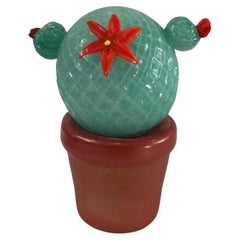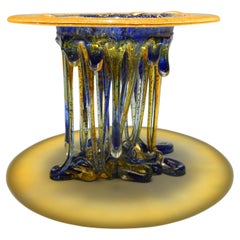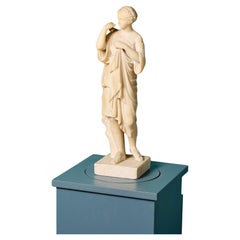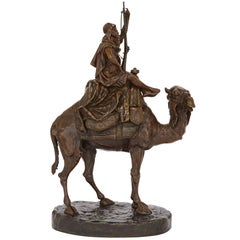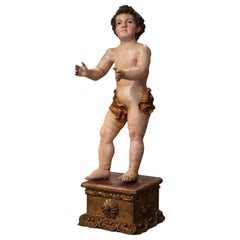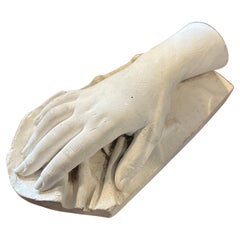Italian Figurative Sculptures
to
630
2,487
559
53
356
693
1,438
612
255
626
394
43
11
45
56
69
101
120
140
78
44
450
403
153
132
125
74
44
34
32
19
11
11
7
3
3
3
1
950
894
657
647
555
1,816
1,156
10,824
3,432
3,099
1,881
1,542
Height
to
Width
to
3,099
2,640
2,932
154
61
56
43
30
Place of Origin: Italian
Murano Art Glass Water Green Cactus Plant, 1990
Located in Rome, IT
Italian design, this cactus is a fashion icon of the Italian style, water green with a beautiful red glass vase underneath.
In limited edition, manufactur...
Category
1990s Mid-Century Modern Italian Figurative Sculptures
Materials
Murano Glass
"Blue, Orange, Gold" Jellyfish, Murano Glass, Handmade Italy, 2025 Centerpiece
By Mosche Bianche
Located in San Miniato PI, IT
The jellyfish is the main element of the Mosche Bianche's "Medusa" Collection: fluid, delicate but also dangerous and deadly. It represents the water, the circle of life.
Glass fus...
Category
2010s Modern Italian Figurative Sculptures
Materials
Art Glass
Antique Grand Tour Alabaster Statue of Diana di Gabii
Located in Wormelow, Herefordshire
An antique Grand Tour alabaster statue of Diana di Gabbi, after the antique. Dating to circa 1890, this expertly hand-carved sculpture is in excellent ...
Category
Late 19th Century Grand Tour Antique Italian Figurative Sculptures
Materials
Alabaster
Large Orientalist Style Patinated Bronze Sculpture by Emile Pinedo
By Émile Pinedo
Located in London, GB
This stunning antique sculpture is finely crafted by Emile Pinedo, who was a master craftsman in creating works of Fine bronze. He is particularly well-kn...
Category
Late 19th Century Antique Italian Figurative Sculptures
Materials
Bronze
18th Century Italian Carved Polychrome Life Size Putti on Stand with Glass Eyes
Located in Dallas, TX
Hand crafted in Italy circa 1780, the antique cherub stands on a square base decorated with shell and foliage motifs. The hand carved sculpture depicts a life size young boy wearing ...
Category
Late 18th Century Neoclassical Antique Italian Figurative Sculptures
Materials
Wood
Neo Classical Plaster Italian Sculpture of a Hand
Located in Catania, Sicilia
This is a Neoclassical Revival Italian plaster sculpture depicting a realistically rendered hand, signed and dated Rome, 25 Agosto 1857. The piece is a fine example of mid-19th century academic craftsmanship, capturing the elegance and anatomical precision characteristic of the Neoclassical style, which was heavily influenced by ancient Roman and Greek art.
The hand is sculpted with incredible attention to detail from the gentle curvature of the fingers to the subtle articulation of the knuckles and fingernails. The plaster surface has a softly textured, matte finish, evoking the look of marble and lending the piece a timeless, classical feel.
This sculpture was intended as a study model or academic cast, often used in art schools or ateliers of the time to teach drawing and sculpting from classical forms. The handwritten inscription of the date and location adds a personal and historical touch, anchoring it to a specific moment in 19th-century Rome —a hub of Neoclassical art and study during that period.
It’s both a decorative object and a historical artifact, perfect for collectors of classical art, academic studies, or antique plaster casts.
Category
Mid-19th Century Neoclassical Revival Antique Italian Figurative Sculptures
Materials
Plaster
Capodimonte Baroque Lady Figurine With Lace Dress, 1900s
By Capodimonte
Located in Lisbon, PT
An exquisite early 20th-century Capodimonte porcelain figurine depicting a Baroque lady dressed in layered lace with floral embellishments.
Handcrafted in Italy around 1900, this tr...
Category
20th Century Baroque Italian Figurative Sculptures
Materials
Porcelain
Large Terracotta Relief - Lombardy, First Half of 17th Century
Located in Bruxelles, BE
Large Terracotta relief of the flight into Egypt
Lombardy, first half of 17th century
Painted terracotta
91 x 85 x 11,5 cm
This event in the early life of Christ is recounted i...
Category
17th Century Baroque Antique Italian Figurative Sculptures
Materials
Terracotta
Huge Capodimonte “Ritorno Dai Campi" by S. Agostino Fine Quality Porcelain Scene
Located in Tustin, CA
“Ritorno dai campi" is a museum quality, limited edition, handmade and hand painted, collectible Capodimonte Italian porcelain by Italian artist, S. Agostino. It is a finely detailed, very large porcelain sculpture depicting a boy riding in a hay filled, horse drawn wagon. The horse has leather reins and is lead by a man with a dog. The man is on foot and holding a hat, and is followed by a barefoot woman with a basket and a rake. The scene is decorated with flowers, a tree and a stump.
Porcelain scene sits on a wooden base with a brass plaque reading "Ritorno Dai Campi Collezione Porcellane S. Agostino"
Signed on the back, “Capodimonte Limited Edition no. 1/100 Made in Italy" with the artist's signature and a blue and white Capodimonte...
Category
20th Century Other Italian Figurative Sculptures
Materials
Porcelain
Lacquered wood sculpture depicting St. Philip Neri
Located in Milano, IT
St. Philip Neri (Florence, 1515 - Rome, 1595) moved to Rome at a very young age and would remain there for the rest of his life. He took courses in theology and philosophy at La Sapi...
Category
17th Century Antique Italian Figurative Sculptures
Materials
Wood, Fir
Ceramic Sculpture by Alessandro Guerriero for Alchimia
By Gruppo Alchimia, Alessandro Guerriero
Located in Milan, Italy
Plaster folded shirt with geometric shapes hand painted in pastel and matte colors. Alchemy production. Handpainted. Unique piece.
Biography
In 1976 Alessandro and Adriana Guerriero established Alchimia, the first example of manufacturing designers in Milan. In 1978 and 1979 they presented the Bau haus and Bau haus II collections. Lamps, armchairs, chairs, tables, cabinets, and so on. Artists involved: Alessandro Mendini, Ettore Sottsass, Bruno and Giorgio Gregori, Michele De Lucchi, Andrea Branzi, UFO, Paola Navone, Daniela Puppa, Franco Raggi. The prevalent decorative material is laminated plastic. Alchimia’s culture, which is against the Italian design (Casabella magazine) changes the base of all previous design theories, resulting in a profound and radical change in the mindset of architects.
Visual Alphabets, Redesign, Trivial Design, Cosmetics and Sentimental Robot are the slogans underlying the exuberant and vast production of Alchimia city. In the theoretical manifesto of the group, Alessandro Mendini writes “Alchimia is not interested in disciplines because they are considered to be within their rules. Indeed, it is important to look into the existing large free spaces between them. Alchimia weighs the assumption that conception and confused production methods should coexist where craftsmanship, manufacturing, information technology, techniques and current and obsolete materials can get mixed up. “They are handcrafted objects, recycled, mass, improbable, provocative, Kitsch, all very theory-laden. It operates and experiences in many sectors: the Pensione Ideale (Franco Raggi), the Copertine di Domus (Occhiomagico), the Abito Sonoro and the performance of Persone Dipinte (Anna Gili), the Stilismo della Moda (Cinzia Ruggeri). The Neo-modern design, the new Italian design, is born.
In 1981, the Mobile Infinito, due to excess, cancelled both the types and project designers, thus entering into theatrical experiment with the Magazzini Criminali.
The emotional, psychological and anthropological activities expand to books, didactics, video (Metamorfosi) and sounds (Matia Bazar). Alessandro Guerriero is a founding member of Domus Academy in 1982 and in 1984, he began Nuova Alchimia...
Category
1990s Modern Italian Figurative Sculptures
Materials
Ceramic
An academic cast depicting Furetti Centaur head, Italy end of 19th century.
Located in Milan, IT
Above the painted black wooden base and a column of red Verona marble is the lava and scagliola powder cast of the head of the young Centaur Ferrets. The original is in Rome, in the ...
Category
Late 19th Century Antique Italian Figurative Sculptures
Materials
Marble
Large Mid-Century Porcelain Woman Figure by Cecchetto Favaro 1950s
Located in Palermo, IT
Large mid-century porcelain woman figure by Cecchetto Favaro 1950s
Intact and in good condition, height 42 cm.
Attribution mark.
Category
1950s Vintage Italian Figurative Sculptures
Materials
Porcelain
Sculptural 18th Century Italian Gilded Angel and Sunrays on Selenite Crystal
By Interi
Located in Dublin, Dalkey
Sculptural 18th century Italian gilded corona, sunrays, figure of Christ, and angel adorned with baroque pearls mounted on selenite crystal.
This piece is based on Revelation 22:1 w...
Category
18th Century Rococo Antique Italian Figurative Sculptures
Materials
Crystal, Rock Crystal, Gold
"Jacob and the Angel" Bronze Sculpture by Bruno Lucchesi
By Bruno Lucchesi
Located in Wiscasset, ME
Signed bronze on marble base
Italian, b. 1926.
Born in 1926 in the village of Fibbiano Montanino, Lucca, Italy, Bruno Lucchesi has been called “the last of the Renaissance scul...
Category
1970s American Craftsman Vintage Italian Figurative Sculptures
Materials
Bronze
Pair of Italian 19th Century Neo-Classical St. Malachite and Ormolu Obelisks
Located in West Palm Beach, FL
A most attractive and very high quality Italian 19th century Neo-Classical st. malachite and ormolu mounted obelisks. Each obelisk is raised by a square malachite...
Category
19th Century Neoclassical Antique Italian Figurative Sculptures
Materials
Malachite, Ormolu
Italian Vintage Pair of Minimalist Crystal Murano Glass Sculptures Man and Woman
By Renato Anatra
Located in New York, NY
Exquisite Italian pair of Murano Art glass sculptures, featuring a contemplative pair of figures - a woman and a man - captured in a moment of meditation and introspection, signed Re...
Category
1980s Organic Modern Vintage Italian Figurative Sculptures
Materials
Art Glass, Blown Glass, Murano Glass
18th Century Italian Figure of Christ with Smoky Quartz Crystals in Coral
By Interi
Located in Dublin, Dalkey
Sculptural 18th century Italian figure of Christ on brown, aged coral, adorned with smoky quartz crystals, mounted on a polished agate base. The figure of Christ was originally part ...
Category
18th Century Rococo Antique Italian Figurative Sculptures
Materials
Quartz, Rock Crystal, Coral
G. Cacciapuoti Art Deco Red Porcelain Stoneware and Wood Woman Profile, 1930s
Located in Meda, MB
This Art Deco sculpture was produced in Italy and more precisely in Milan, by Guido Cacciapuoti in the 1930s.
The base is in ebonized wood and the sculpture, a typical Art Deco sty...
Category
1930s Art Deco Vintage Italian Figurative Sculptures
Materials
Ceramic, Stoneware, Wood
Large Carpiè Porcelain Statue, Made in Italy, 1970s
Located in Palermo, IT
Large Carpiè porcelain statue, made in Italy, 1970s
52 cm high, it is intact. Wedding gift from my grandparents.
Category
1970s Vintage Italian Figurative Sculptures
Materials
Porcelain
Murano Art Glass Green and Orange Cactus Plant, 1990
Located in Rome, IT
Italian design, this cactus is a fashion icon of the Italian style, green with a beautiful amber glass vase underneath.
In limited edition, manufactured in one of the furnaces in Ve...
Category
1990s Mid-Century Modern Italian Figurative Sculptures
Materials
Murano Glass
Capodimonte late 19th Century White Porcelain Group of Male and Female Figurines
By Capodimonte
Located in Firenze, IT
A lovely antique Italian Capodimonte white porcelain biscuit male and female figurines sculptured in the round depicting in a very romantic moment. This centrepiece group features tw...
Category
19th Century Romantic Antique Italian Figurative Sculptures
Materials
Porcelain
The Odalisque, Ancient Bronze Sculpture by Giuseppe Salvi
Located in Roma, IT
Silver plated Bronze representing a young odalisque, realized in 1886 by the Italian sculptor Giuseppe Salvi (1836-1905).
Signature, place and year engraved on base: G. Salvi fece Roma 1886. On base: "Fond. Nelli Roma...
Category
1880s Antique Italian Figurative Sculptures
Materials
Bronze
Ceramic Art Deco Woman Artist Pattarino
By Eugenio Pattarino
Located in Buenos Aires, Argentina
Ceramic Art Deco Woman artist Pattarino
wooden base origin italy
Art Deco.
Category
Early 1900s Art Deco Antique Italian Figurative Sculptures
Materials
Ceramic
END OF THE 19th CENTURY MARBLE PLAQUE ATTRIBUTABLE TO DOSSENA
Located in Firenze, FI
Beautiful carved white marble plaque, depicting a noblewoman with elegant hair typical of the 14th century and inside a trefoil arch, supported by twisted columns. The plaque can be ...
Category
Late 19th Century Antique Italian Figurative Sculptures
Materials
Marble
Rare Romanesque Capital Depicting Four Africans, Apulia, 13th Century
Located in Bruxelles, BE
Large stone capital carved on each side in strong relief. The basket is covered with two crowns of vertical acanthus leaves which sprout from the astragal and fill the space between ...
Category
15th Century and Earlier Medieval Antique Italian Figurative Sculptures
Materials
Stone
Mid Century 1970s Italian Blue Purple Lucite Grapes Fruit Cluster on Driftwood
Located in Toronto, CA
A stunning midcentury piece, this oversized blue and purple Lucite grape cluster on a natural driftwood stem is an elegant addition to any space. The grapes, each individually wired ...
Category
1970s Mid-Century Modern Vintage Italian Figurative Sculptures
Materials
Lucite, Driftwood
Carrara Marble Sculpture Signed Prof. Bastiani Firenze, Italy, circa 1890
Located in Buenos Aires, Buenos Aires
Carrara marble sculpture signed Prof. Bastiani Firenze, Italy, circa 1890.
By Ildebrando Bastiani.
Category
1890s Islamic Antique Italian Figurative Sculptures
Materials
Carrara Marble
Contemporary Art Sculpture Se Dio Carving on Rough Wood by Urano Palma
By Mirabili, Urano Palma
Located in Pistoia, IT
Chair sculpture on rough wood.
... So many chairs, so many benches, so many big tables, all with the wrinkled skin of old tree trunks or of rusted metal sh...
Category
1980s Post-Modern Vintage Italian Figurative Sculptures
Materials
Wood
Postmodern Hand Carved and Burnished Stone Egg and Holster Set, Memphis Inspired
By Ettore Sottsass
Located in Brooklyn, NY
Carefully curated set of semi-precious stone and glass eggs in vibrant colors with corresponding Lucite platform bases for display. Set is comprised o...
Category
Late 20th Century Post-Modern Italian Figurative Sculptures
Materials
Quartz, Alabaster, Granite, Marble
Amazing Sculptures" Naiad Teti and Naiad Doris " (7 in the World) Terracotta
Located in Madrid, ES
Amazing Sculptures" Naiad Teti and Naiad Doris " (7 in the World) Terracotta Impruneta 20th Century
Representation of the Naiads by Giambologna, present in Florence in Piazza della ...
Category
20th Century Modern Italian Figurative Sculptures
Materials
Terracotta
Sailboat Sculpture in Murano Glass by Alberto Donà
By Alberto Donà
Located in Oud Beijerland, NL
Beautiful Murano Glass sculpture designed and fabricated by Alberto Donà in Italy in the 80's.
This glass sail boat is hand blown and crafted in very nice blue and yellow colors.
W...
Category
1980s Modern Vintage Italian Figurative Sculptures
Materials
Murano Glass
Pop Comic Artistic Murano Glass Sculpture
By Roberto Beltrami
Located in Murano, VE
Turtle sheriff, handmade blown sculpture by Roberto Beltrami.
Part of a comic and pop collection in Murano glass, the 'PUPI' are 100% mouth-blown and entirely handmade, offering com...
Category
2010s Modern Italian Figurative Sculptures
Materials
Murano Glass
Vintage Brass Object Representing a Sail Boat in the style of Hagenauer
Located in Bresso, Lombardy
Made in Italy, 1940s
This sculpture is made in nickel-plated brass and features a lacquered beech pedestal.
It might show slight traces of use since it's vintage, but it can be consi...
Category
1940s Mid-Century Modern Vintage Italian Figurative Sculptures
Materials
Brass, Nickel
Pair of 19th Century Italian Alabaster Classical Figures of Muses
Located in London, GB
A pair of very finely carved 19th century alabaster figures of muses, in classical dress, each standing on circular pedestals intricately carved with flowers and beading, Italian, c....
Category
Mid-19th Century Neoclassical Antique Italian Figurative Sculptures
Materials
Alabaster
Pair of porcelain bisque sculptures depicting the dioscuri
Located in Milano, IT
The two sculptures depict two horses tamed by two young men. The subject can be traced back to the iconography of the dioscuri, which originated in Greek, Roman, and Etruscan mytholo...
Category
19th Century Antique Italian Figurative Sculptures
Materials
Porcelain
Late 17th Century Italian School Wooden Sculpture of Saint Anthony and the Child
Located in Leuven , BE
According to the legends, there are two Saint Anthony’s, they can easily be distinguished by their hair. This one is known as Saint Anthony of Padua, he is recognizable by his hair, ...
Category
Early 17th Century Antique Italian Figurative Sculptures
Materials
Wood
Italian Figural Walnut Centrepiece of Dionysus, 19th Century
Located in ARMADALE, VIC
Italian Figural Walnut Centrepiece of Dionysus
19th Century
Provenance:
Private Australian Collection.
Description:
A walnut figure modelled on the bronze ‘Narcissus’ found in N...
Category
19th Century Neoclassical Antique Italian Figurative Sculptures
Materials
Walnut
Two rare Figures in Turkish Attire - Venice, early 17th century
Located in Bruxelles, BE
Rare Bronzes Depicting two Figures in Turkish Attire
Possibly Suleiman the Magnificent at two different ages
bronzes, alabaster bases
Venice, early 17th century
19,5 x 6 x 5 cm
These two rare bronze statuettes represent two figures dressed in elaborate "Turkish" attire. They are mounted on alabaster bases with bronze reliefs—one featuring the winged lion of Venice, and the other possibly symbolizing Turkey with a wolf depiction.
One figure wears a grand külah, a spherical turban with a cone top, signifying royal authority, while the other has a wrapped turban, denoting rank and religious identity. Their garments are richly detailed with intricate engravings, suggesting luxurious fabrics of the Ottoman court.
The statuettes may represent Suleiman the Magnificent at two different stages of life, as both young and old. The sultan depicted alongside the winged lion corresponds to a description from a Venetian delegate in 1534, when Suleiman was 43. At that time, he had conquered Iraq from the Safavids and achieved a decisive victory over the Papal fleet at the Battle of Preveza. He was described as having large eyes, an aquiline nose, and long red mustaches—traits visible in Cristofano dell'Altissimo’s portrait of Suleiman in the Uffizi Gallery in Florence.
Unlike Mehmed II, who commissioned portraits by European artists for diplomatic purposes, Suleiman did not directly order such representations. Instead, his likeness spread through works by artists like Albrecht Dürer, based on sketches made by diplomats. Following his capture of Belgrade in 1521, his victory over Hungary in 1526, and his siege of Vienna...
Category
17th Century Renaissance Antique Italian Figurative Sculptures
Materials
Alabaster, Bronze
Extremely Rare Flavio Poli Glass Lion, 1930
By Flavio Poli
Located in Rome, IT
Lion
Flavio Poli 1930
white glass "sommerso"
Manufactured by IVAM Murano
Measures: 39 x17 cm
repaired with resin on a foreleg and in a part of the crest
Literature: i...
Category
1930s Art Deco Vintage Italian Figurative Sculptures
Materials
Sommerso, Glass
Pop Comic Artistic Murano Glass Sculpture Bull
By Roberto Beltrami
Located in Murano, VE
Fighting bull, is a blown glass sculpture created by Roberto Beltrami, in Murano glass.
Part of comic and pop collection in Murano glass, the 'PUPI' are 100% mouth-blown and entirely...
Category
2010s Modern Italian Figurative Sculptures
Materials
Murano Glass
Pop Comic Artistic Murano Glass Sculpture
By Roberto Beltrami
Located in Murano, VE
Heedless beaver, is a blown glass pop comic figurine created by Roberto Beltrami, in Murano glass.
Part of a comic and pop collection in Murano glass, the 'PUPI' are 100% mouth-blow...
Category
2010s Modern Italian Figurative Sculptures
Materials
Murano Glass
Apollo Belvedere in Carrara marble
Located in Rome, IT
Sculpture of Apollo Belvedere in Carrara marble from a private Roman collection. ADDITIONAL PHOTOS, INFORMATION OF THE LOT AND SHIPPING INFORMATION CAN BE REQUEST BY SENDING AN EMAIL...
Category
Mid-20th Century Italian Figurative Sculptures
Materials
Marble
Sculpture marble Mercury-Hermes, from the model by Thorvaldsen
Located in Rome, IT
Sculpture of Mercury-Hermes, in marble, reproduction based on a work by the Danish neoclassical artist Thorvaldsen (1770-1844), second half of the 20th century. ADDITIONAL PHOTOS, IN...
Category
Mid-20th Century Italian Figurative Sculptures
Materials
Marble
Hand Carved Italian Santo
Located in Houston, TX
Hand carved Italian Santo: figure of Franciscan abbot or saint, circa 1780-1800.
Note: Regional differences in humidity and climate during shipping may...
Category
Late 18th Century Baroque Antique Italian Figurative Sculptures
Materials
Wood
renaissance wooden candelabrum and painted cross - Umbria, 16th century
Located in Bruxelles, BE
Base of a carved wooden candelabrum, polychrome and gilded; cross painted on both sides.
Umbria or Tuscany, 16th century
136 x 43,5 x 30 cm
(The cross and the base of the candelabrum were later assembled)
The base of the candelabrum is intricately carved and adorned with polychrome and gilded finishes. The shafts take on the shape of balusters reminiscent of ancient columns, feature ornate foliage decorations, garlands and winged cherub faces. The feet are crafted in the likeness of lion paws. The base is further embellished with depictions of four saint martyrs, among them Saint Barbara and Saint Catherine of Alexandria. The plasticity of the figures, outlined with strong contour lines, the clear and vibrant colors, are stylistic elements linked to the Umbrian tradition of the sixteenth century.The precisely defined and elegant drawing, along with the clear color palette applied with refined chiaroscuro modulations, became the signature of a style that would leave a lasting mark on the era to come. This is exemplified by a preference for vibrant, multicolored images, accentuated in this case by the use of red and pink in the saint's attire.
A notable addition, introduced later, is a polylobed cross painted on both sides. On one side, the Crucifixion is vividly portrayed:The treatment of the corpus itself is in line with High Medieval practice, emphasizing pathos by showing Jesus dead, his arms sagging from the weight of the body. The upper section displaying a pelican pecks at her breast to feed her young with her own blood; a symbol of the sacrifice of Christ on the cross whose body and blood similarly nourishes the celebrant during Mass.
The lower part depicts Golgotha. On the reverse side, the Resurrection is artistically presented in a Renaissance iconography, reminiscent of the renowned composition painted by Piero della Francesca, now housed in the Civic Museum of Sansepolcro. In terms of composition, with the frontal depiction of Christ holding the banner, this motif became particularly widespread in central Italy, spanning from Tuscany to Umbria throughout the 16th century..
The double-sided construction suggests that it may also have been carried in liturgical processions. In Umbria from the 14th century, the use of portable crosses painted on both sides had become a widespread practice, aimed at satisfying the monastic clientele that had significantly increased following the establishment of new religious communities.
The earliest surviving Tuscan painted crucifix represent Christ as Christus Triumphans, or the “Triumphant Christ” with his head up and eyes open. This form was supplanted in the 13th century with the Christus Patiens, or “Suffering Christ” type who is shown often with his head fallen on his shoulder and his eyes closed, as In our cross. The iconography of the suffering Christ appears to have developed out of a new interest in Christ’s human nature, the development of the feast of Corpus Christi and with increased importance given to the Eucharist. The process of humanizing the figure of Christ reaches its peak with the abandonment of all the previous expressive conventions in favor of more realistic details we can observe in this Crucifix, such as the swollen belly, the arms stretched to the limit of muscle tearing, the body falling heavily forward, the abundant blood on
the wounds, and the cross firmly embedded in the rock of Calvary.
It's worth noting that Renaissance candelabra...
Category
16th Century Renaissance Antique Italian Figurative Sculptures
Materials
Wood, Giltwood
Alabaster Woman Bust with Marble Base, Firenze, circa 1890
By Ferdinando Vichi
Located in Buenos Aires, Buenos Aires
Alabaster woman bust with marble base. Firenze, circa 1890.
Siena marble base.
Category
1890s Art Nouveau Antique Italian Figurative Sculptures
Materials
Alabaster, Siena Marble
Italian 19th Century White Carrara Marble Statue of Hebe
By Cesare Lapini
Located in West Palm Beach, FL
A beautiful and high quality Italian 19th century white Carrara marble statue of Hebe. The statue is raised by a circular base where the beautiful Hebe is standing barefoot in front ...
Category
19th Century Antique Italian Figurative Sculptures
Materials
Marble
Santi Buglioni, terracotta roundel depicting "St. Andrew"
Located in Milano, IT
Santi Buglioni (Florence, 1494 - 1576)
Glazed polychrome terracotta roundel depicting
"St. Andrew within a wreath of fruits and flowers," 70 cm diameter
Category
16th Century Antique Italian Figurative Sculptures
Materials
Pottery
Clelia Le Bertetti, Large Nude Sculpture, 1920s, Ceramic
Located in Montelabbate, PU
Large nude Le Bertetti Turin, executed by Clelia Le Bertetti figure no. 13 signed at the base.
Category
1920s Art Deco Vintage Italian Figurative Sculptures
Materials
Ceramic
True Pair Of Italian 19th Century Neo-Classical St. White Carrara Marble Statues
Located in West Palm Beach, FL
A powerful and most handsome true pair of Italian 19th century Neo-Classical st. white Carrara marble statues of soldiers. Each soldier stands atop a stepped square pedestal with mot...
Category
19th Century Neoclassical Antique Italian Figurative Sculptures
Materials
Marble
Italian 19th Century Alabaster and Marble Statue
Located in West Palm Beach, FL
An elegant and decorative Italian 19th century alabaster and marble statue of a Greek goddess Ariadne seated on her panther. Gazing towards her left while her elbow rests on her pant...
Category
19th Century Antique Italian Figurative Sculptures
Materials
Alabaster, Marble
19th Century Statue of St Jerome
Located in Allerum, SE
Early 19th century wooden statue of St Jerome, circa 1800. South Europe.
Category
Early 1800s Baroque Antique Italian Figurative Sculptures
Materials
Wood
Carrara Marble Sculpture "Ariadne on the Panther" Signed A. Frilli, Firenze
By Antonio Frilli
Located in Buenos Aires, Buenos Aires
Carrara marble sculpture "Ariadne on the Panther" signed A. Frilli, Firenze, Italy, circa 1890.
Dimensions green marble pedestal: 114 cm.
Category
Late 19th Century Neoclassical Antique Italian Figurative Sculptures
Materials
Carrara Marble
Original Sculpture / Seat Mod Up7 Designed by Gaetano Pesce, B&B Italia
By Gaetano Pesce
Located in Ibiza, Spain
The large seat/sculpture mod. Up7, designed by the renowned Italian architect and designer Gaetano Pesce in 1969, represents a milestone in contemporary furniture design. Produced by B&B Italia as part of the UP series...
Category
Early 2000s Italian Figurative Sculptures
Materials
Plastic
Andrea Leoni The Wrestlers, after the Antique
Located in New York, NY
The wrestlers, after the antique
Statuary Marble
Signed dated Located "A Leoni di Firenze Fecit L'ano 1835".
Category
19th Century Antique Italian Figurative Sculptures
Materials
Statuary Marble
Yellow Banana Ceramic Sculpture, Zanolli Nove Italy, circa 1970
By Rita Zanolli
Located in Firenze, IT
Yellow banana ceramic sculpture
Zanolli Nove Italy, circa 1970
Measures: 48 x 15 x 20 cm
Conditions: Excellent.
Category
1970s Mid-Century Modern Vintage Italian Figurative Sculptures
Materials
Ceramic
Bronze Casting from the 1930s Giovanni De Martino
By Giovanni De Martino
Located in bari, IT
De Martino is a classical artist, known for the production of sculptures of small bronze busts, in particular (“scugnizzi”, fishermen, commoners) with realistic features.
He trained at the Academy of Fine Arts in Naples under the guidance of Stanislao Nome, Gioacchino Toma, and Achille D ’Orsi, from whom he learned the ability to portray the most realistic details using them on very young subjects. Very young he moved to Paris where he performed small sculptural groups, exhibiting frequently at the "Paris Salon" where he won the prize of the Louvre Museum for the bronze work Le Pêcheur de criquets (The Fisher of locusts, Naples, private collection).
Returning to Naples, he returned to a socialist realism and produced sculptures depicting characteristic Neapolitan types, especially urchins, “street urchins”, little boys and young fishermen. From 1916-1931 he was master of the sculptor Angelo Frattini.
Later the dominant theme of his production was childhood, in particular thoughtful, sad, gaunt children were represented in his works, on whose faces the signs of abandonment and suffering emerged. De Martino became known with the nickname of “The sculptor of children”.
Category
1930s Other Vintage Italian Figurative Sculptures
Materials
Bronze
